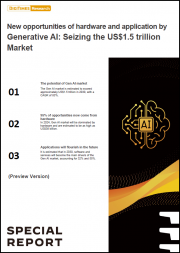
|
시장보고서
상품코드
1548971
생성형 AI에 의한 하드웨어 및 애플리케이션의 새로운 기회 : 1조 5,000억 달러 시장의 장악New Opportunities of Hardware and Application by Generative AI: Seizing the US$1.5 Trillion Market |
||||||
인공지능(AI) 연구는 1940년대에 시작되어 1960년대부터 1980년대까지 전문가 시스템, 자연어 처리, 머신러닝 등의 분야에서 비약적인 발전을 이루었으며, 1980년대 비즈니스에서의 전문가 시스템 활용, 1997년 체스 세계 챔피언 갈리 카스파로프를 이긴 IBM의 Deep Blue, 2016년 바둑 세계 챔피언 이세돌 9단을 이긴 알파고 등 중요한 이정표를 세웠습니다. 챔피언 갈리 카스파로프를 이긴 IBM의 Deep Blue, 2016년 바둑 세계 챔피언 이세돌 9단을 이긴 알파고 등 중요한 이정표가 있으며, AI 기술이 빠르게 발전함에 따라 다양한 분야에서의 응용이 더욱 심화되고 보급되어 의료, 교육, 교통, 제조업 의료, 교육, 교통, 제조업 등에 혁명적인 변화를 가져올 것으로 기대되고 있습니다.
지난 11월, OpenAI는 대규모 언어 모델 ChatGPT를 발표하여 순식간에 전 세계의 주목을 받았으며, ChatGPT는 인간과 같은 텍스트를 생성할 수 있고, 대화, 작문, 번역 등에 탁월하여 AI 개발의 중요한 이정표가 되었습니다. ChatGPT는 머신러닝을 기반으로 한 대화 시스템으로서 자연어를 이해하고 생성하여 사용자와 의미 있는 대화를 할 수 있게 함으로써 언어 이해와 생성에 있으며, AI를 발전시키고 있습니다.
이 보고서는 생성형 AI의 현황, 잠재적 적용 사례, 도전과제를 살펴보고, 다양한 분야의 사례 연구를 통해 생성형 AI의 능력과 한계를 평가합니다. 주도하는 세계 생성형 AI 시장은 빠르게 성장하여 2024년 400억 달러에 달하고, 2030년에는 미국에서 1조 5,000억 달러 규모로 성장할 것으로 예측했습니다. 최근 성장은 주로 클라우드 서버와 AI 컴퓨팅 칩에서 각종 AI 단말 장비에 이르기까지 AI 하드웨어 시장에 기인합니다. 이 보고서에서는 각 하드웨어 시장의 발전 추세와 주요 레이아웃을 분석합니다. 장기적인 성장 모멘텀은 다양한 용도에서 생성형 AI의 구현에서 비롯되며, 응용 시나리오의 발전과 잠재력을 통해 미래의 비즈니스 기회 가치를 설명합니다.
목차
제1장 생성형 AI 연표
- 생성형 AI의 부상
- 생성형 AI 정의
- 생성형 AI알고리즘의 개발 실적
- 생성형 AI 가치와 과제
- 생성형 AI 새로운 동향
제2장 생성형 AI 계산 능력의 개발
- 클라우드 서버
- 기업 서버
- PC, 노트북, 휴대폰
- 기타 : IoT 디바이스
- 생성형 AI 클라우드와 엣지 컴퓨팅 향후 동향
제3장 생성형 AI 애플리케이션 사례
- 스마트 교통
- 스마트 소매
- 스마트 의료
- 스마트 제조
- 스마트홈
결론
KSA 24.09.20AI research emerged in the 1940s and made breakthroughs in areas like expert systems, natural language processing, and machine learning from the 1960s to the 1980s. Essential milestones include the use of expert systems in business during the 1980s, IBM's Deep Blue defeating world chess champion Garry Kasparov in 1997, and AlphaGo defeating world Go champion Lee Sedol in 2016. With AI technology rapidly advancing, its applications in various fields are expected to become more profound and widespread and bring revolutionary changes in healthcare, education, transportation and manufacturing.
In November 2022, OpenAI launched ChatGPT, a large-scale language model that quickly garnered global attention. ChatGPT can produce human-like text and excels in dialogue, writing, translation, and more, marking a significant milestone in AI development. As a conversational system based on machine learning, ChatGPT comprehends and generates natural language, enabling meaningful interactions with users and advancing AI in language understanding and generation.
This article delves into the current state of generative AI, its potential applications, and its challenges, examining case studies across various domains to assess its capabilities and limitations. DIGITIMES Research predicts that led by Amazon, Google, Meta, Microsoft, NVIDIA, OpenAI and others, the global generative AI market will grow rapidly, reaching US$ 40 billion in 2024 and growing to US$ 1.5 trillion US in 2030. The recent growth mainly comes from the AI hardware market, from cloud servers and AI computing chips to various AI terminal devices. This report will analyze the development trends and key layouts of each hardware market; as for the long-term growth momentum, it will come from the implementation of generative AI in various application fields and will describe the future business opportunity value from the development and possibilities of application scenarios.
Table of Contents
Chapter 1: A Chronology of Generative AI
- 1.1. The rise of generative AI
- 1.2. Definition of Generative AI
- 1.3. Development history of generative AI algorithms
- 1.4. The Value and Challenges of Generative AI
- 1.5. New trends in generative AI
Chapter 2: The development of computing power of generative AI
- 2.1. Cloud Servers
- 2.2. Enterprise Servers
- 2.3. PCs, Notebooks and Handsets
- 2.4. Others: IoT devices
- 2.5. The future trend of cloud and edge computing in generative AI
Chapter 3: Examples of generative AI applications
- 3.1. Smart Transportation
- 3.2. Smart Retail
- 3.3. Smart Healthcare
- 3.4. Smart Manufacturing
- 3.5. Smart Home















